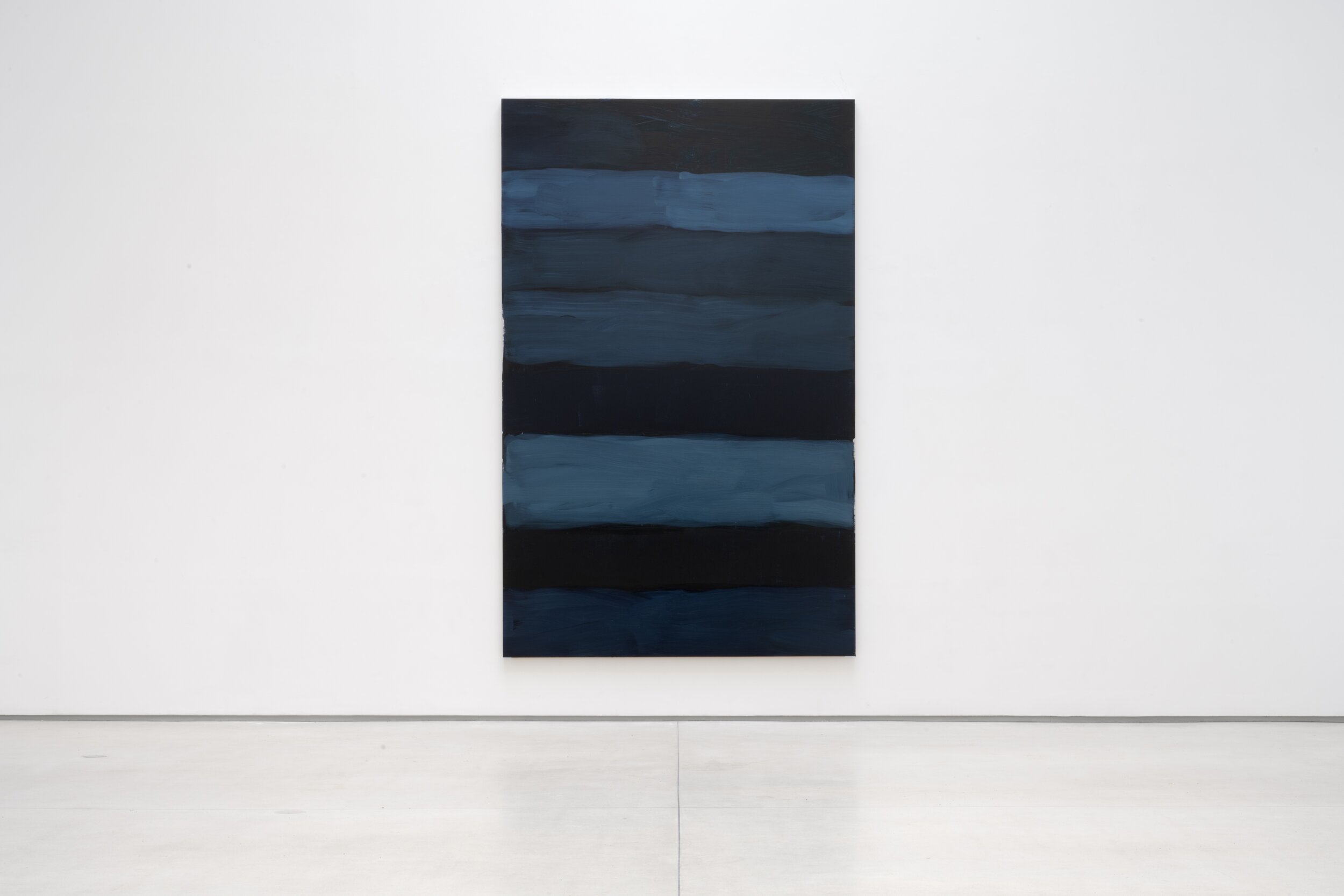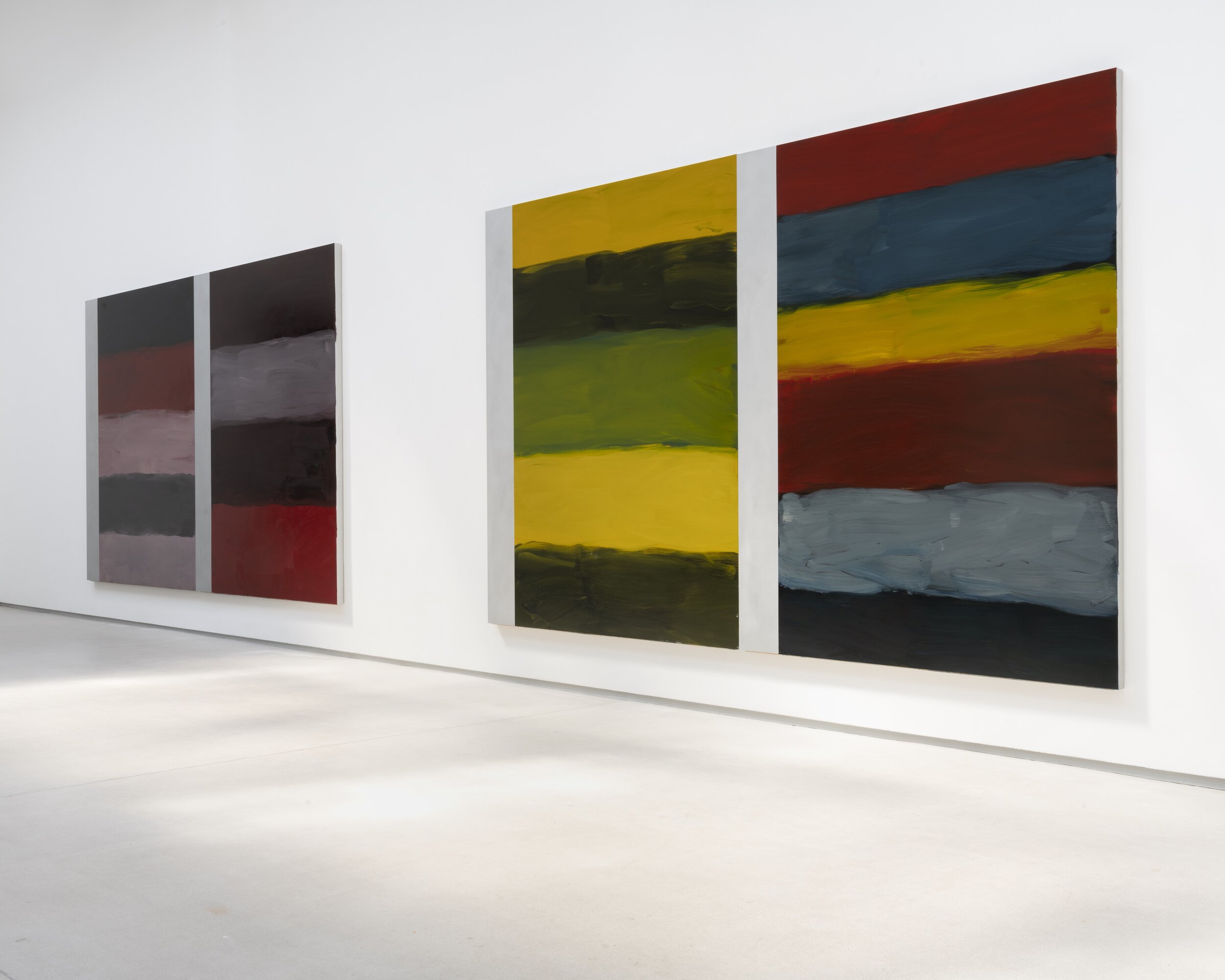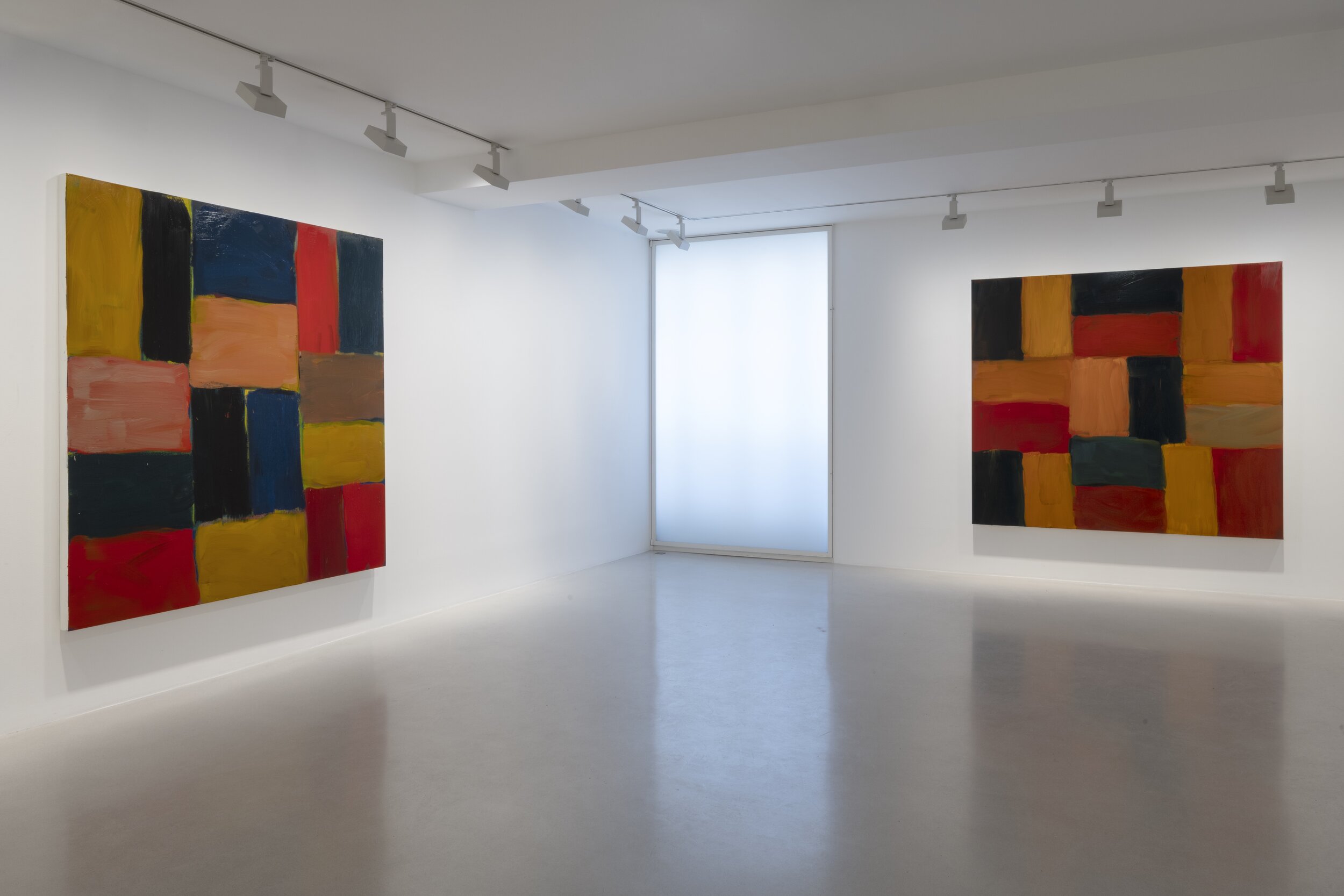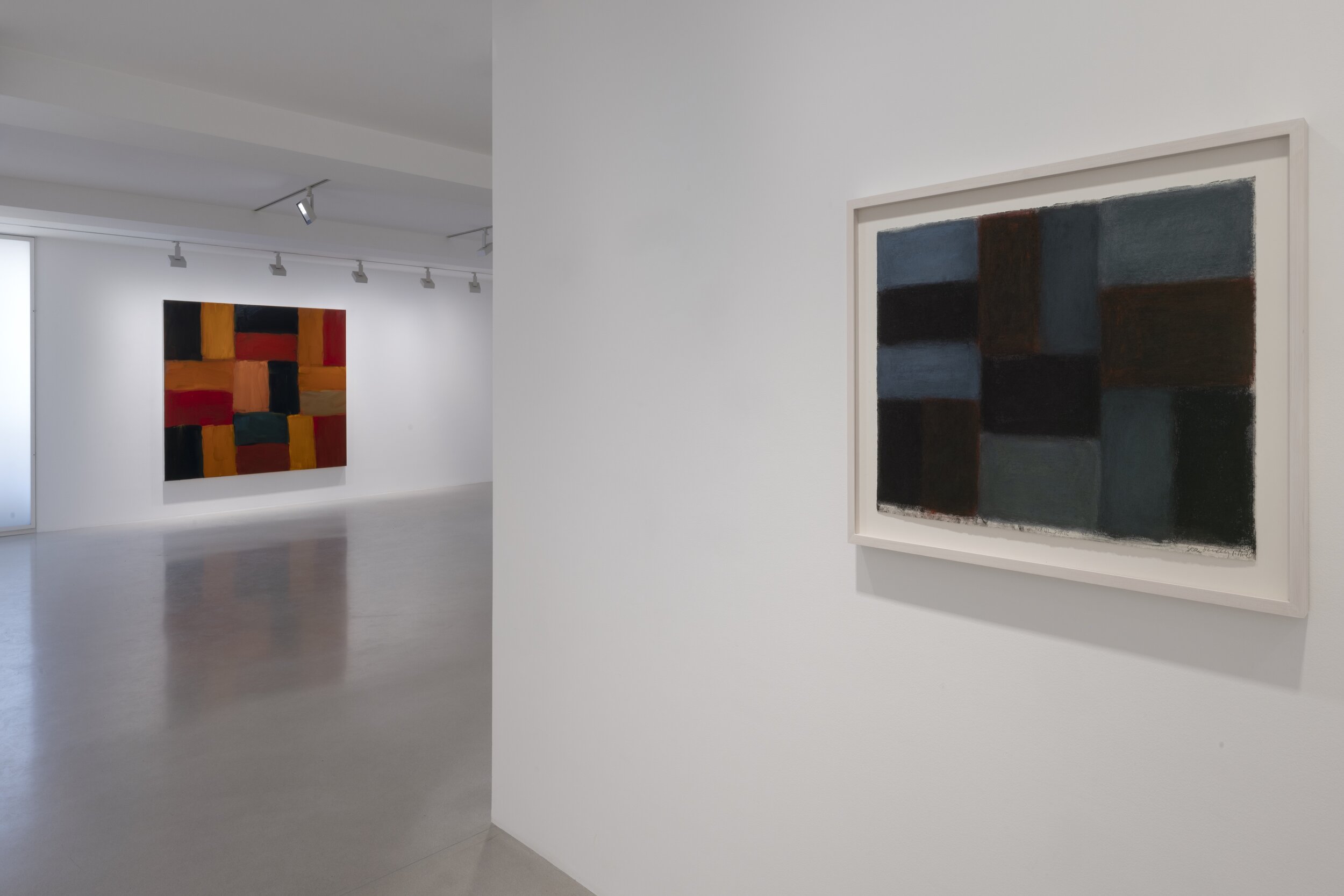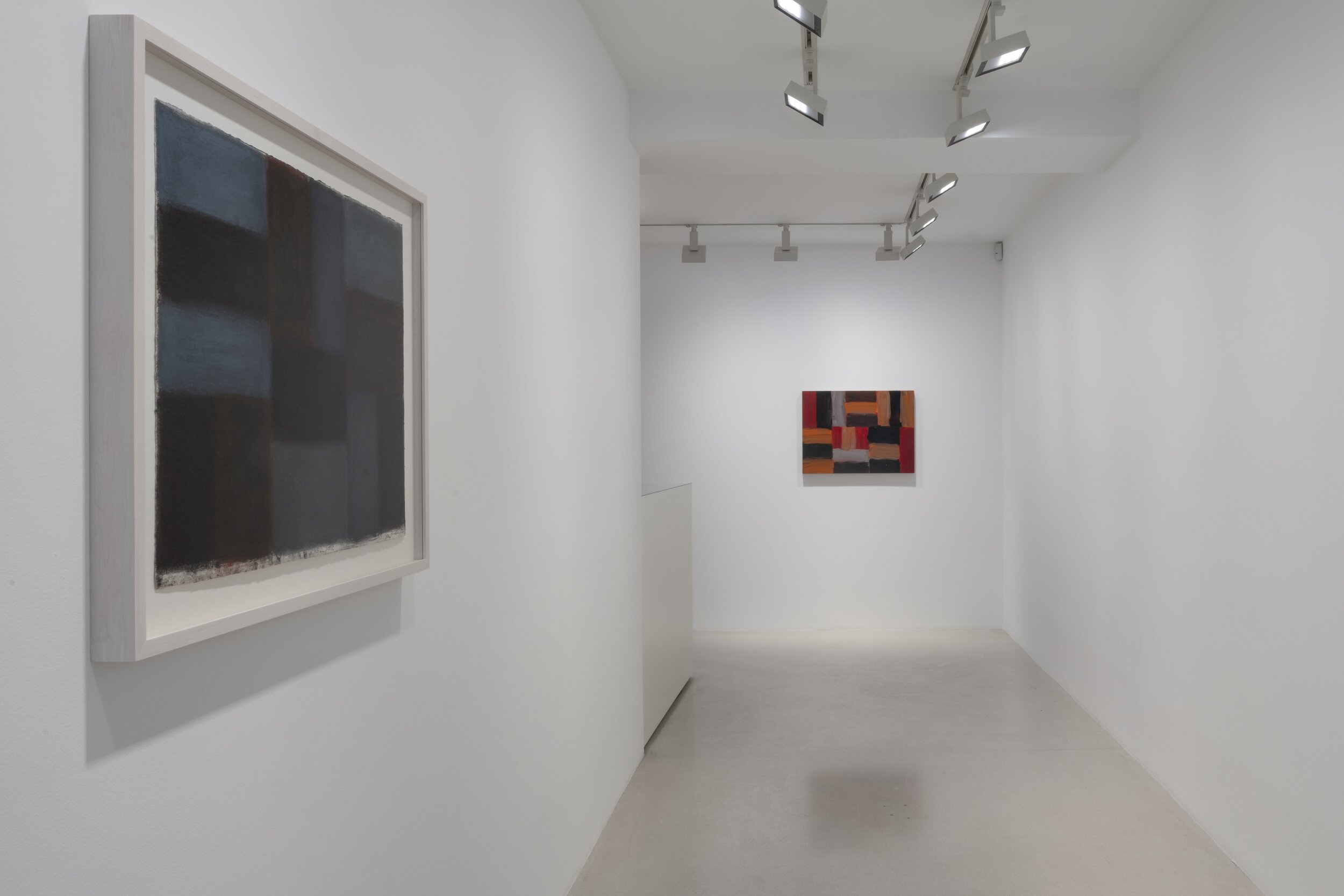Sean Scully: Between Heaven and Earth, installation view at Thaddaeus Ropac Paris Marais. Photograph by Charles Duprat. Courtesy of the artist and Galerie Thaddaeus Ropac.
Sean Scully:
Painting’s Ontology
Sean Scully: Between Heaven and Earth
Galerie Thaddaeus Ropac Paris Marais
April 24 through July 29, 2021 | Review by Raphy Sarkissian
When art is dressed in the most threadbare cloth, we recognize it most clearly as art.[1] —Friedrich Nietzsche
Jet black, scarlet, vivid crimson, rusty red, carmine, imperial red and shades of Spanish grey intermixed with orange hues: these might be a few of the chromatic designations of the rectangular blocks that evoke masonry in the ravishing painting titled Wall Orange Black of Sean Scully, executed in 2020. This somewhat modestly scaled oil-on-linen painting, measuring about 24 by 32 inches, absorbs the viewer through the fleshiness of its painterly surface, where the whiskers of the brush at once organize the fundamentally geometric composition and transubstantiate the ideality of linear forms into pulsating shimmers of light. Touches of color through bouncing brushstrokes suspend the distinctions of opacity and translucence, for Scully’s handling of oil has transformed the linen surface into a sensorial palette of lavish chromatic crescendos of heightened painterliness.
Sean Scully, Wall Orange Black, 2020. Oil on linen, 23 13/16 by 32 1/4 inches. Photograph by Charles Duprat. Courtesy of the artist and Galerie Thaddaeus Ropac.
The inaugural exhibition of Scully at Galerie Thaddaeus Ropac in Paris showcases recently executed abstract works that remain in arresting formalist and conceptual dialogues with painting’s ontology. Three main formalist trajectories can be considered to govern the structural elements of the seventeen oil paintings and one watercolor, presented under the poetic title Between Heaven and Earth. This allegorical title can be interpreted as a reference to what lies between the Apollonian and Dionysian on one of its most primeval levels within the domain of mark-making. Or, to borrow the formalist terminology and concepts of Aloïs Riegl, the paintings of Scully embody what lies between the optical and tactile, between subjectivism and objectivism, between the visually apprehended and concrete realities of the world.
First, in one set of paintings on view, whose titles often begin with the terms “wall” or “landline,” the medium of oil conceals the entirety of the pictorial surface, articulating such patterns as the altered checkerboard motif or chromatically alternating horizontal bands rendered fluidly. Such paintings as Wall Pink, Wall Black White, Wall Red Yellow Blue and Wall Orange, all executed in 2020, encapsulate a modernity where Piet Mondrian’s Apollonian ideality of form has become transformed into a lush, Dionysian viscerality.
Sean Scully, Wall Landline Dark Yellow, 2021. Oil on aluminum, 85 by 75 inches. Photograph by Charles Duprat. Courtesy of the artist and Galerie Thaddaeus Ropac.
Second, in a pair of paintings on view, Scully’s signature inset comes into play, whereby a fundamental set of exchanges take place between the concepts of support and frame, inside and outside, plane and space, form and amorphousness. The five horizontal bands of Wall Landline Dark Yellow (2021) function as backdrop of the pictorial stage set, enveloping the aluminum square inset that is a variation of the checkerboard motif series. This synthesis of the wall and landline motifs through vivid and subdued coloration expressively evokes the architectonic within its landscape setting. Yet the visual unity of the second lower horizontal band nearly dissolves into the incased panel, loosening figure-ground relations, an operation that also takes place to a given extent between various other sections of the inner and outer surfaces of the painting.
Sean Scully: Between Heaven and Earth, installation view at Thaddaeus Ropac Paris Marais. Photograph by Charles Duprat. Courtesy of the artist and Galerie Thaddaeus Ropac.
In Black Window Pale Land (2020), on the other hand, the structure of the support remains primarily similar to that of Wall Landline Dark Yellow, while the austere palette adheres to shades of gray and black. The inset here, a black monochrome, echoes Kazimir Malevich’s Black Square (1913) at the State Tretyakov Gallery in Moscow, now set within grey horizontal bands that come across as highly gestural translations of Agnes Martin’s two-tone gray painting Untitled #5 (1990) of the Whitney Museum of American Art. As the lowermost band in shades of charcoal acts as a virtual foreground, it heightens the sense of atmospheric spatiality of the five alternating bands.
Sean Scully: Between Heaven and Earth, installation view at Thaddaeus Ropac Paris Marais. Photograph by Charles Duprat. Courtesy of the artist and Galerie Thaddaeus Ropac.
And third, in a suite of four large-scale paintings whose titles begin with the term “mirroring,” each of the landscape-format work displays horizontal stripes on an aluminum support, while vertical “margins” on the leftmost side of the panel and to the right of the vertical central axis reveal the bare surface of the metallic substructure. Though the compositions of these paintings are based upon a sense of rational order and thus convey an Apollonian message, the Turnerian brushwork overturns the geometric organization of forms into Dionysian dithyrambs. It is this simultaneity of form and formlessness that suspends Mirroring Maroon (2020) between its incarnation of figments of the Romantic sublime and the austerity of the medium of oil-on-aluminum as an intrinsic system. Indeed, there is a sense of utter specificity within the titles Mirroring 4.12.20 and Mirroring Yellow 4.5.20, titles that await the sheer openness of the observer’s consciousness and imagination to enclose the paintings within their own subjectivity or the events of the world on those particular dates, reminding us of On Kawara’s meditative paintings that point to time and temporality.
Sean Scully: Between Heaven and Earth, installation view at Thaddaeus Ropac Paris Marais, with Mirroring, 4.12.20 on the left. Photograph by Charles Duprat. Courtesy of the artist and Galerie Thaddaeus Ropac.
The mirroring series of the exhibition manifests Scully’s ongoing investigation of painting’s ontology through color, form and support, bringing into mind Michel Foucault’s discourse on the ontology of linguistic representation in The Order of Things:
Comparing language to a picture, one late-eighteenth-century grammarian defines nouns as forms, adjectives as colors, and the verb as the canvas upon which the colors are visible. An invisible canvas, entirely overlaid by the brightness and design of words, but one that provides language with the site on which to display its painting. What the verb designates, then, is the representative character of language, the fact that it has its place in thought, and that the only word capable of crossing the frontier of signs and providing them with a foundation in truth never attains to anything other than representation itself. So that the function of the verb is found to be identified with the mode of existence of language, which it traverses throughout its length: to speak is at the same time to represent by means of signs and to give signs a synthetic form governed by the verb.[2]
Hence the place of the verb in the general scheme of linguistic representation can be conceptualized according to the analogy that the proposition within language corresponds to representation within thought, where the verb, on the level of the proposition, is the essential link between the subject and its predicate. It is their “copulation,” as Thomas Hobbs would call it.[3]
Sean Scully: Between Heaven and Earth, installation view at Thaddaeus Ropac Paris Marais. Photograph by Charles Duprat. Courtesy of the artist and Galerie Thaddaeus Ropac.
What Foucault also argues, however, about the archaeology of the verb, is that the epistemological role of the verb as “the only word capable of crossing the frontier of signs and providing them with a foundation in truth”—which “never attains to anything other than representation itself”—was to disappear and become homogenized into those of the other parts of speech.[4] Yet twentieth-century critical thought was to reinsert the conditions and function of the essential verb—to be—into the domain of its discourse. The works of Ferdinand de Saussure and Jacques Derrida, for example, are preeminent instances of the inquiry into the nature of (verbal) signification. With this reentry of the structure and semiosis of being or logos into the discursive realm of modern thought was the inquiry of the phonetic and graphic attributes of being. The visual arts, in their turn, were to experience an equivalent shift. In Mirroring Green (2020) of Scully, the three elements of color, form and surface respectively present themselves as visual counterparts of adjective, noun and verb.
As Scully states in the press release of the gallery, the recently executed paintings of the “mirroring” cycle can be read as allegories of the printed pages with margins: “They kind of look like pages of a book with margins. I was sent to work in a printing factory when I was fifteen. The idea of printing is very strong in me, as is the idea of rows. It’s all coming from my adolescence, when I used to set type. The idea of reflection is very present in my work.”[5] Indeed, this reference of the artist to labor intriguingly runs parallel to the title of the penultimate chapter of The Order of Things, “Labor, Life, Language.” Foucault concludes the chapter by writing: “At the moment when language, as spoken and scattered words, becomes an object of knowledge, we see it reappearing in a strictly opposite modality: a silent, cautious deposition of the word upon the whiteness of a piece of paper, where it can possess neither sound nor interlocutor, where it has nothing to say but itself, nothing to do but shine in the brightness of being.”[6] The words of Scully integrate painting and the world of labor, insisting upon the inseparability of modernism’s captivated gaze from the technologizing of the body. Foucault’s title “Labor, Life, Language” bears an unmistakable resonance with Scully’s statement of 2004: “I didn’t start writing until I was fifty. I didn’t think that I could say something until I’d done something.”[7] Here, the threads of language and thought become once again interwoven with those of labor, “low art” and “high art.”
Sean Scully: Between Heaven and Earth, installation view at Thaddaeus Ropac Paris Marais. Photograph by Charles Duprat. Courtesy of the artist and Galerie Thaddaeus Ropac.
Liliane Tomasko at work on a 2016 remake of Magic Carpet, originally made in 1993. Photograph by Sean Scully. Courtesy of Liliane Tomasko and Sean Scully.
While the formal vocabulary of Scully has been rigorously reduced to strips and stripes, horizontal and vertical bands, the inset and bare surface of the metallic support, the gestural application of oil and chromatic parameters of a given work construct a painterly model that attaches emotive mark-making to the structural logic of cultural production at one of its most essential and theoretical levels. That visual logic, as perceptively discussed by Pascal Rousseau in the essay of the exhibition catalogue, “The Art of Necessity,” indicates the relations between the “warps and wefts” we find in Paul Cézanne’s pictorial construction of his favorite model Marie-Hortense Fiquet in the process of sewing in Portrait of the Artist’s Wife (1877) of the Nationalmuseum in Stockholm.[8] Madame Cézanne in a Red Armchair (circa 1877) of the Museum of Fine Arts in Boston is another example through which Rousseau attentively ties Scully’s recurrent motif of parallel bands to “the visual scansion of the stripes on the dress in the lower part of the composition” of the painting.[9]
Paul Cézanne, Portrait of the Artist’s Wife, 1877. Oil on canvas, 23 7/16 by 19 1/2 inches. Courtesy of the Nationalmuseum, Stockholm.
Paul Cézanne, Madame Cézanne in a Red Armchair, circa 1877. Oil on canvas, 28 1/2 by 22 inches. Courtesy of the Museum of Fine Arts, Boston.
Furthermore, Rousseau draws parallels between Cézanne’s process of painting Fiquet through the rhythmic patches and his wife’s stitching of a garment, parallels that in turn recur between Scully’s “sewing” of the most fundamental tectonic forms and his wife Liliane Tomasko’s “stitching” of a grid through threads spread horizontally upon the surface of the floor, as in her 1993 project titled Magic Carpet.[10] Thematically, we are here also reminded of Georges Seurat’s 1882-83 drawing Embroidery (The Artist’s Mother) of the Metropolitan Museum of Art. While Seurat’s handling of Conté crayon on textured Michallet paper and the processes of embroidering, knitting or sewing undo the hierarchy of high art and low craft, Magic Carpet of Tomasko reveals the logic of the material structure of the canvas, with the warp and weft of textile design entirely undone and yet organized within the structure of a horizontal grid. Whereas the appliquéd fabric of Blanket (1911) of Sonia Delaunay of Centre Pompidou redefines the grid as a matrix whose square cells have replaced the Platonic ideality of form by the amorphous tactility of fabric with trapezoidal and cursively-outlined cells, Tomasko’s Magic Carpet has further disintegrated the fabric, evoking Untitled (1968) of Robert Morris of the Museum of Modern Art in New York, where the formlessness of thread left from a textile manufacturing is scattered horizontally on the floor, with double-sided vertical mirrors punctuating vision’s opticality. The tactility of Untitled of Morris and Magic Carpet of Tomasko both annunciate amorphousness, destabilizing the difference between part and whole, between “high art” (vertical) and “low art” (horizontal).
Georges Seurat, Embroidery (The Artist’s Mother), 1882-83. Conté crayon on Michallet paper, 12 5/16 by 9 7/16 inches. Courtesy of the Metropolitan Museum of Art, New York.
Paul Cézanne, Madame Cézanne in a Striped Dress, 1885-86. Oil on canvas, 24 3/8 by 20 1/8 inches. Courtesy of the Philadelphia Museum of Fine Arts, Philadelphia.
Robert Morris, (Untitled), 1968. Felt, asphalt, mirrors, wood, copper tubing, steel cable, and lead, dimensions variable, approximately 21 1/2 inches by 21 feet 11 inches by 16 feet 9 inches. Courtesy of the Museum of Modern Art, New York.
Sean Scully, Wall of Light Cubed, 2007. Granite, 65 by 26 by 13 feet. Image courtesy of the artist and Château La Coste, France. Photograph by François Deladerrière.
Sean Scully, Wall of Light Cubed (detail), 2007. Granite. Image courtesy of the artist and Château La Coste, France.
Sean Scully, Wall Doric 1.11.20, 2020. Pastel on paper, 22 7/16 by 30 3/16 inches. Courtesy of the artist and Galerie Thaddaeus Ropac.
In 2007, referring to his Wall of Light Cubed in Château La Coste near Aix-en-Provence, Scully wrote, “If in the future someone from another cultural matrix, who doesn’t value my cultural matrix, takes off a stone or two or three to build something else: it will still survive. Its compressing stubbornness will still hold it together. It pushes in and what you cannot see you can feel. You know it is cubed.”[11] While Cézanne captures the complexity of visual perception by “weaving” his patches of color so as to attain fundamental elements of resemblance, Scully “weaves” his reversible figures and grounds so as to formulate an ontology of painting in relation to its remote and close histories. Rousseau eloquently sheds light on the aesthetic trajectories of both Tomasko and Scully through the theoretical concepts of Gottfried Semper regarding cultural style. In his book titled Style in the Technical and Tectonic Arts; or, Practical Aesthetics, Semper draws parallels between the infrastructure of masonry, ceramics, carpentry and textiles, viewing them to be as significant as the totality of architecture. As Rousseau notes, “For Semper, as for Scully, there is no autonomy in art, insofar as autonomy presupposes a break between true art with high aspirations—‘genuine art,’ according to Clement Greenberg and his formalist doxa—and the more ‘minor’ arts, with their purely decorative concerns (pottery, ceramics, carpets, etc.).”[12] The three cycles comprising Between Heaven and Earth continue Scully’s investigation of the ontology of painting, suspending the hierarchization of “humble artifacts” and “great art.”
Sean Scully: Between Heaven and Earth, installation view at Thaddaeus Ropac Paris Marais. Photograph by Charles Duprat. Courtesy of the artist and Galerie Thaddaeus Ropac.
Written in 1994 within a brief essay titled “Abstract Painting,” Scully lucidly states the foundation of his painterly practice: “I make my paintings in layers, and the edges are complex and uncertain. This gives my paintings a real reference to time and to work: something carried by a human being involving real time and real work and search and arriving somewhere, but not trying self-consciously to make an effect.”[13] Scully’s layers of paint and uncertainty of edges define the rectangular cells of his matrix, whereby swaths of color render masonry and the interlaced fibers of linen underneath analogous. The halation of radiant orange in Wall Orange Black invites the observer’s attention to the materiality of the tactile oil medium and the ever-shifting possibilities of the unrestrained grid that generates chromatic effects of pigments and their interactions with light in relation to visual perception. Mirroring 4.12.20, on the other hand, lays bare the indispensable aluminum substratum of pulsating shades of blues and browns that reverberate as primordial emblems of earth, sky and horizon. In both of these instances, Scully continues his investigation of the essentials of form and matter. Between Heaven and Earth thus unveils an Apollonian organization of chromatic surfaces that have been realized through a Dionysian facture. The paintings on view infer the ontology of Sean Scully’s mark-making process, ascribing the specificity of the medium to life, language and labor.
Timothy Greenfield-Sanders, Portrait of Sean Scully, 1991. Black and white photograph, 20 by 16 inches. Courtesy of Timothy Greenfield-Sanders and the Broad, Los Angeles, California.
Notes
Friedrich Nietzsche, “Against Originals” (Aphorism 179), in Human, All Too Human (1879), trans. Marion Faber and Stephen Lehmann (Lincoln and London: University of Nebraska Press, 1984), p. 119.
Michel Foucault, The Order of Things (New York: Vintage, 1973), pp. 95-96.
Foucault, p. 93.
Foucault, p. 96.
Sean Scully, quoted in “Press Release,” Galerie Thaddaeus Ropac (Paris: April 2021).
Foucault, p. 300.
Scully, “Work” (2004), in Inner: The Collected Writings and Selected Interview of Sean Scully, ed. Kelly Grovier (Berlin: Hatje Cantz, 2016), p. 142.
Pascal Rousseau, “Sean Scully: The Art of Necessity,” in Sean Scully: Between Heaven and Earth (Paris: Galerie Thaddaeus Ropac, 2021), p. 39.
Rousseau, ibid.
Rousseau, p. 44.
Scully, “Wall of Light Cubed” (2007), in Inner, p. 229.
Rousseau, p. 46.
Scully, “Abstract Painting” (1996), in Inner, p. 54.
Sean Scully is currently represented by Lisson Gallery in New York, Kerlin Gallery in Dublin, Kewenig in Berlin and Galerie Thaddaeus Ropac in Paris.
Sean Scully: Between Heaven and Earth, installation view at Thaddaeus Ropac Paris Marais. Photograph by Charles Duprat. Courtesy of the artist and Galerie Thaddaeus Ropac.

